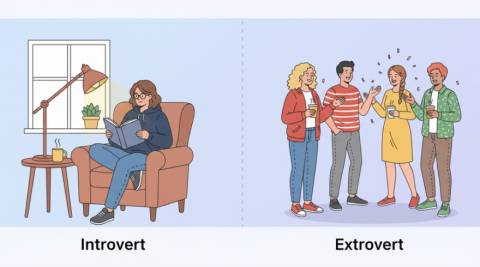Your Guide to Understanding the Introversion–Extraversion Spectrum Through Modern Quizzes

What These Quizzes Measure and Why the Spectrum Matters
Human energy patterns vary widely, and the introversion–extraversion spectrum helps explain why some people recharge in solitude while others thrive amid bustling collaboration. Instead of labeling, the most useful assessments reveal gradients of preference, context, and adaptability. They translate complex psychological research into accessible language that everyday readers can grasp without prior training in personality theory or psychometrics.
Within minutes, the introvert or extrovert quiz frames your social energy, sensory thresholds, and reflection style in a friendly, digestible snapshot. By focusing on situational prompts it invites self-observation rather than prescriptive judgment. Thoughtful questions also weigh how mood, environment, and purpose shape your responses, because no one is the exact same person at work, home, or on a crowded train.
For comparison-minded readers, an approachable introvert vs extrovert quiz contrasts tendencies like spontaneous talking versus contemplative pausing. You’ll see how social acceleration and recuperation differ between individuals who prefer fast-paced group dialogue and those who prefer depth-first one-on-one exchanges. To make this feel personal and practical, a modern personality quiz introvert extrovert also highlights unique strengths, such as quiet pattern detection or bold idea evangelism, so you can lean into what makes you effective.
Benefits, Use Cases, and Real-world Payoffs
Clear language about energy style can reduce friction in teams, classrooms, and families by normalizing how people work best. Rather than stereotyping, a carefully designed instrument promotes empathy, clarifies boundaries, and accelerates collaboration. For individuals, the result can be confidence in choosing recovery rituals, smarter scheduling, and calibrated social commitments that fit your nervous system and values.
Career explorers often appreciate how an are you introvert or extrovert quiz translates into job search strategy, interview prep, and networking approaches that feel authentic. In relationship dynamics, the right insights support healthier communication, because partners can anticipate each other’s needs for space, stimulation, or decompression after long days. Teams that practice this vocabulary tend to reassign meeting formats, reimagine brainstorming, and adopt flexible workflows that honor diverse energy rhythms.
- Streamline meetings by matching formats to group energy.
- Balance deep work blocks with connective touchpoints.
- Prevent burnout with planned recovery time after intensity.
- Design inclusive events that mix quiet corners and lively forums.
- Coach students and employees with personalized interaction styles.
Managers frequently use an extrovert introvert quiz to guide mentorship pairings and presentation roles that showcase complementary strengths. For job seekers, the results help craft cover letters that highlight genuine collaboration preferences instead of generic buzzwords. Individuals refining self-care routines also gain clarity on noise levels, social dosage, and focus strategies that align with an evidence-informed understanding of themselves. After reflection, many learners turn to an am i introvert or extrovert quiz to confirm patterns observed over time, then set realistic goals for growth without forcing a personality overhaul.
How These Assessments Work, Plus a Quick Interpretation Framework
Most modern tools rely on situational prompts, Likert scales, and cross-domain scoring that weave together social drive, sensory sensitivity, and cognitive pacing. Beyond the score labels, you’ll typically receive tailored suggestions for communication, rest, and learning environments. After setup, people often appreciate a logical walkthrough of inputs, safeguards, and outputs that make the experience transparent.
To start on solid footing, users often sample an am i extrovert or introvert quiz with clear instructions, time estimates, and privacy disclosures. The following overview shows the common flow from questions to insights, plus why each step matters for reliability and actionability.
| Step | What You Do | Why It Matters |
|---|---|---|
| 1. Context | Read how to answer based on typical behavior, not rare exceptions. | Improves accuracy by reducing situational bias. |
| 2. Items | Respond to prompts about social energy, focus, and recovery. | Captures multiple facets of the spectrum, not just talkativeness. |
| 3. Scoring | Receive scaled results across several domains and subdomains. | Reveals nuance beyond a single letter or rigid type. |
| 4. Guidance | Review personalized tips for work, relationships, and learning. | Transforms data into practical, day-to-day decisions. |
| 5. Reflection | Compare results with lived experience and solicit feedback. | Anchors insights in reality and invites iterative growth. |
Results commonly land on a continuum that includes flexible middle-ground patterns, which is why many people gravitate to an introvert extrovert ambivert quiz when they resonate with both quiet depth and social excitement. Instead of forcing a binary choice, the better frameworks show how context flips your optimal mode, such as public speaking on familiar topics versus casual small talk at large events. Your personal blend becomes a map for choosing energy-smart habits that keep motivation high and stress manageable.
When you want to test this middle zone more thoroughly, an am i introvert extrovert or ambivert quiz often separates social appetite from stimulation tolerance, which makes the guidance far more precise. That means your plan might emphasize structured mixers, brief collaboration sprints, or predictable agendas that remove unnecessary noise. Insightful summaries also recommend recovery rituals, think silent walks, journaling, or music breaks, so your momentum doesn’t collapse after peak output.
Putting Insights to Work at School, on Teams, and at Home
Once you understand your energy preferences, you can design routines that respect both focus and connection. People who value deep concentration may block mornings for analytical work, while those who draw energy from group exchanges might schedule collaborative tasks early to spark momentum. For career navigation, a thoughtful what type of introvert am i quiz can help you align roles with communication cadence, presentation exposure, and recovery time that fits your physiology and goals.
- Use pre-meeting briefs for quieter thinkers to prepare talking points.
- Offer hybrid brainstorms that include written idea rounds before live sessions.
- Rotate facilitation to match hosts with fitting energy demands.
- Create quiet zones and lively zones in shared spaces to reduce friction.
- Schedule buffer time between intensive classes, calls, or events.
Educators and mentors increasingly explore typologies and subtypes to provide nuanced coaching, especially when students display mixed patterns across settings. For those curious about granularity, a well-crafted 4 types of introverts quiz teases apart social, thinking, anxious, and restrained styles without pathologizing any of them. With this clarity, learners can request environments that align with processing speed, social dosage, and recovery styles, resulting in better grades and calmer classrooms.
Parents and youth counselors have special reasons to seek child-friendly language and age-appropriate prompts. For developmental sensitivity and gentle framing, families often choose an introvert extrovert quiz kids experience that uses simple scenarios and playful illustrations. With compassionate explanations, children can feel understood rather than labeled, and caregivers gain practical ideas for transitions, bedtimes, and playdate formats that fit the child’s unique rhythm.
FAQ: Expert Answers to Common Questions
How accurate are online introversion–extraversion quizzes?
Quality varies, but well-designed tools use validated question structures and multi-domain scoring to reflect nuance. Accuracy improves when you answer based on typical behavior and recent patterns, not best-case aspirations. The most useful results also include interpretation notes and suggestions to cross-check insights with real-world feedback from colleagues or loved ones.
Can my results change over time?
Yes, results can shift with life stage, stress levels, job demands, and skill development. People often become more adaptable through practice, learning to operate effectively in contexts that once felt draining. Consider retesting after major transitions or every year to recalibrate routines and goals.
Is one style better for leadership?
Neither style guarantees success; effective leaders design systems that leverage their natural strengths and compensate for blind spots. Quiet leaders might excel at thoughtful decision-making and 1:1 coaching, while outgoing leaders often energize teams and build quick alignment. The best approach is deliberately situational and supported by complementary teammates.
How should I apply the results at work?
Translate insights into calendar choices, meeting formats, and communication norms. For deep work, protect uninterrupted blocks and reduce notification noise. For collaboration, use agendas, timeboxing, and written brainstorms to include multiple thinking styles without exhausting anyone’s energy reserves.
What if I feel “in between” most of the time?
Many people experience a shifting middle ground depending on context, topic familiarity, and social stakes. Embrace that flexibility by scheduling recovery after high-intensity collaboration and seeking structure for challenging social situations. Your goal is an energy portfolio that balances stimulation and restoration throughout the week.
Latest News



